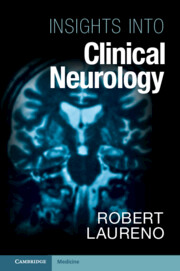Book contents
- Insights into Clinical Neurology
- Insights into Clinical Neurology
- Copyright page
- Dedication
- Contents
- Preface
- Acknowledgments
- Chapter 1 The Amnesic Syndrome
- Chapter 2 Aphasia, Apraxia, and Agnosia
- Chapter 3 Spurious Symptoms and Behaviors
- Chapter 4 Hallucinations
- Chapter 5 Grasping and the Grasp Reflex
- Chapter 6 Asterixis
- Chapter 7 Discussion of the Upper Motor Neuron Syndrome
- Chapter 8 Some Aspects of the Lower Motor Neuron Syndrome
- Chapter 9 The Limbic System
- Chapter 10 Vibration Sensation, the Posterior Columns, and Related Topics
- Chapter 11 Transneuronal Effects
- Chapter 12 Spinal Nerve Roots
- Chapter 13 Ischemic Hypoxic Encephalopathy
- Chapter 14 The Liver–Brain Relationship in Wilson Disease
- Chapter 15 Wernicke Disease
- Chapter 16 Delayed Neurologic Disorders after Toxic or Metabolic Insults
- Chapter 17 Transolfactory Spread in the Pathogenesis of Meningoencephalitis
- Chapter 18 Neurologic Disorders in Endocarditis
- Chapter 19 Secondary Abscess Formation in Primary Brain Lesions
- Chapter 20 Progressive Multifocal Leukoencephalopathy: The Early Years
- Index
- References
Chapter 5 - Grasping and the Grasp Reflex
Published online by Cambridge University Press: 27 July 2023
- Insights into Clinical Neurology
- Insights into Clinical Neurology
- Copyright page
- Dedication
- Contents
- Preface
- Acknowledgments
- Chapter 1 The Amnesic Syndrome
- Chapter 2 Aphasia, Apraxia, and Agnosia
- Chapter 3 Spurious Symptoms and Behaviors
- Chapter 4 Hallucinations
- Chapter 5 Grasping and the Grasp Reflex
- Chapter 6 Asterixis
- Chapter 7 Discussion of the Upper Motor Neuron Syndrome
- Chapter 8 Some Aspects of the Lower Motor Neuron Syndrome
- Chapter 9 The Limbic System
- Chapter 10 Vibration Sensation, the Posterior Columns, and Related Topics
- Chapter 11 Transneuronal Effects
- Chapter 12 Spinal Nerve Roots
- Chapter 13 Ischemic Hypoxic Encephalopathy
- Chapter 14 The Liver–Brain Relationship in Wilson Disease
- Chapter 15 Wernicke Disease
- Chapter 16 Delayed Neurologic Disorders after Toxic or Metabolic Insults
- Chapter 17 Transolfactory Spread in the Pathogenesis of Meningoencephalitis
- Chapter 18 Neurologic Disorders in Endocarditis
- Chapter 19 Secondary Abscess Formation in Primary Brain Lesions
- Chapter 20 Progressive Multifocal Leukoencephalopathy: The Early Years
- Index
- References
Summary
The grasp reflex and the instinctive grasp response differ in their necessary stimulus, level of motor integration, and clinical utility. The grasp reflex proper results from a combined cutaneous and proprioceptive stimulus. It is a stereotyped reflex due to disease of the supplementary motor area of the contralateral frontal lobe. More complex is the instinctive grasp response which involves groping. Its stimulus is purely tactile. A different phenomenon is the alien hand syndrome in which the hand has a will of its own.
- Type
- Chapter
- Information
- Insights into Clinical Neurology , pp. 33 - 40Publisher: Cambridge University PressPrint publication year: 2023

